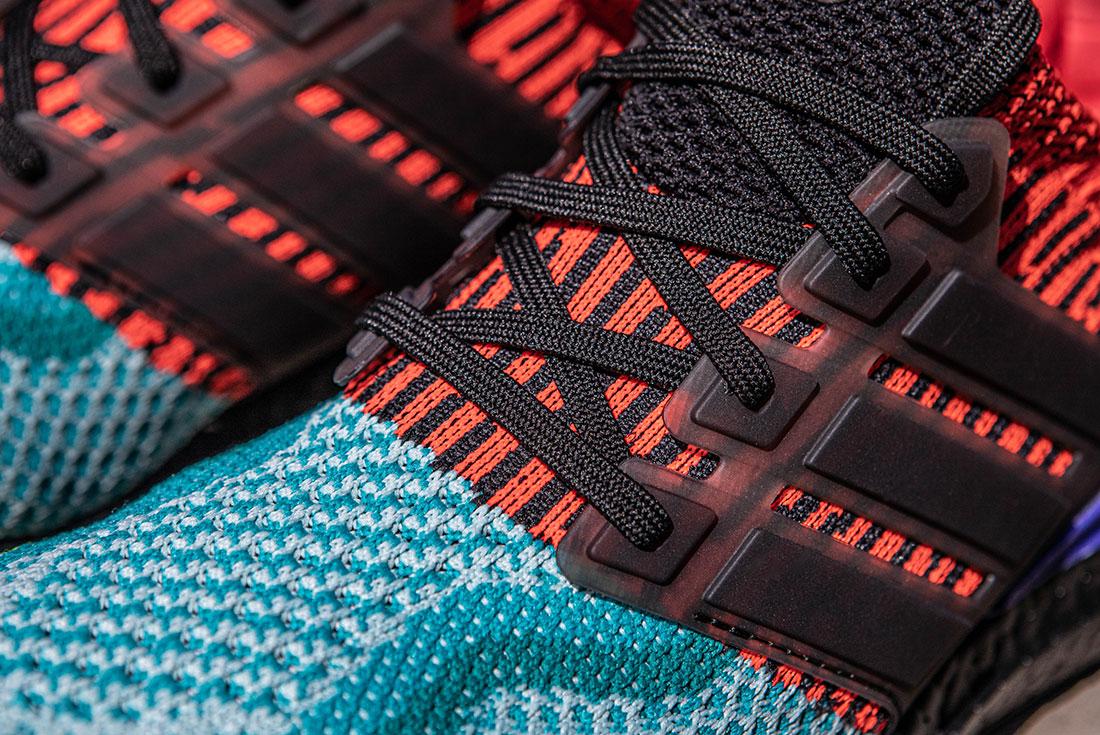Material Matters: adidas Primeknit
Transcending its original performance pedigree, technology has snuggled the feet of everyone from marathon masters to #TeamCozy legends. Eight years after it was introduced, Primeknit’s seamless woven structure has been propelled into wider consciousness thanks to the and , two sock-fit models that define the knitted sneaker genre. As adidas continue weaving Primeknit into the rich tapestry of contemporary sneaker history, their latest UltraBOOST DNA release celebrates the runner-slash-lounger legacy in all its multicolour splendour.
The Primeknit Primer
Shoes may look relatively simple from the outside – appearing to be just an upper attached to a sole unit – but the top half usually contains at least a dozen different components and panels. This is how footwear has been designed and constructed for centuries, but with increased focus on efficiency and sustainable production methods, adidas is one of the key players in streamlining that process.
Primeknit is adidas’ method of reducing those multiple parts into a single continuous woven piece. Created using specialised knitting machines that utilise thermoplastic yarns, the end result is a strong and flexible single-layered textile in the shape of a shoe. This flat pattern is modified at particular sections for cosmetic purposes, such as adding contrast colours or branding. Tighter weaves add structural support, while more relaxed areas allow for enhanced ventilation and flex.
Waste Not, Want Not
The fact that Primeknit is a single piece of material has several advantages. Firstly, it makes for an extremely lightweight sneaker. The knitted nature also creates a sock-like fit, adapting to feet of all shapes and sizes. And because it’s one piece, the single seam required to join the pattern together can be placed in an unobtrusive location.
Beyond the material benefits of Primeknit, its widespread use helps the planet at a granular level by optimising the raw materials required to make a shoe. By using a fixed length of yarn to produce the exact amount of material for the upper, nothing is wasted from cut-offs. This may only seem like saving a few grams of textile per shoe, but it becomes a significant factor when considering the massive production scale of adidas.
A long-standing partnership with , the marine conservation organisation, has helped adidas make waves in improving the sustainability of their products. that began in 2015 with the UltraBOOST Uncaged have showcased the use of Parley Ocean Plastic, which weaves fibres made from plastic waste extracted from the sea into Primeknit material.
Knit Happens
Let’s flip the calendar back to 2010. Inspired by a glove knitted from fused thermoplastic fibres, adidas product developers Astrid Lang and Stefan Tamm realised the yarn could form a strong, light and flexible textile perfect for knitting an upper for a sneaker. With immense R&D and production power at their disposal, adidas scrambled to test their new technology on the world’s biggest stage – the London 2012 Summer Games.
The adiZero Primeknit was adidas’ lightest-ever sneaker at the time, and was limited to a ceremonial 2012 pairs. It showcased adi’s German manufacturing prowess and offered a glimpse at an innovative future. A rapid sell-out affirmed the proof of concept, and Primeknit remained a hot topic in sneaker forum threads long after the closing ceremony in London.
Team Cozy
Following the launch of the adiZero Primeknit, adidas began massively scaling up production of their new textile tech, rolling it out across their performance categories. Primeknit has also been used to create lightweight and breathable jackets for the outdoors-focused range, and for ultralight sports bras.
The development of midsole technology in 2013 inevitably created the adiZero Prime BOOST, which was the first adidas shoe to combine Primeknit with BOOST cushioning. However, it wasn’t until 2015 that Primeknit and BOOST took centre stage thanks to the introduction of UltraBOOST. Heralded as the next major advancement of the convergent technologies, it was a hit with both runners and sneakerheads for its instant comfort right out of the box and easy styling. Soon after, this tech pairing underscored futuristic designs like the NMD and simultaneously updated Originals icons such as the , not to mention the monolithic and monochromatic series. While these releases had comfort-seeking #TeamCozy sneakerheads embracing all combinations of the two new technologies, many kept returning to the perfection of the UltraBOOST.
UltraBOOST Legacy
UltraBOOST is arguably the pinnacle of Primeknit design. In the five short years since its debut, the UB has become one of adi’s most talked-about and highest selling models. Debates still rage online and IRL over which of the model’s first four Primeknit patterns is the favourite among sneakerheads, while OG colourways and killer colabs keep hype levels high.
The brief yet explosive history of the UB is what adidas proudly celebrate with the UltraBOOST DNA ‘Legacy’, a neon-drenched kaleidoscopic melange of wild weaves that flexes the full potential of Primeknit technology. With colours like ‘Solar Slime’ and ‘Night Flash’ paired to the blacked-out BOOST sole (an Easter Egg for long-time UB fans), the commemorative edition will have hardcore trainerspotters trying to pick out the Primeknit patterns used across this UltraBOOST.
For more info, check out the UltraBOOST DNA ‘Legacy’ over at right now.
